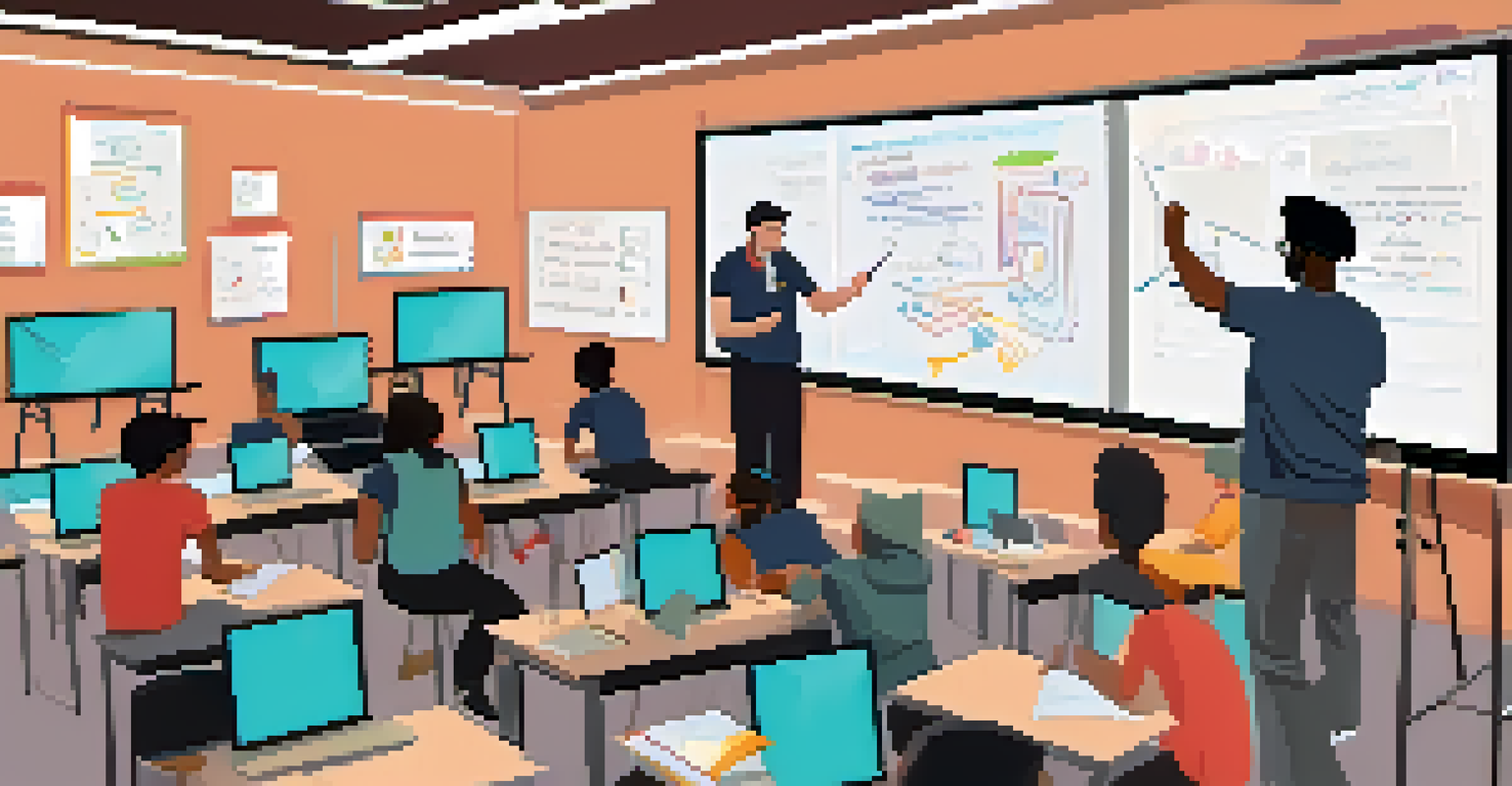Open Source Software in Education: Opportunities and Challenges

Understanding Open Source Software in Education
Open source software (OSS) refers to programs whose source code is freely available for modification and distribution. In education, this means students and educators can access a plethora of tools without the burden of expensive licenses. This accessibility can empower learners, fostering a culture of collaboration and innovation. Imagine a classroom where students can tweak and improve the tools they use; that’s the essence of open source in education.
Open source is a philosophy, a way of life, and a way of making software that is accessible to everyone.
OSS can encompass anything from educational platforms to coding software, providing diverse resources for various subjects. For example, platforms like Moodle are widely used for creating online courses and are entirely open source. This versatility allows educators to tailor their teaching tools to better fit their specific educational needs. By leveraging open source software, schools can create a more engaging and personalized learning experience.
However, while the benefits are clear, it's essential to understand that open source doesn’t mean ‘no cost’ in terms of support or training. Educators may need to invest time in learning how to implement and maintain these tools effectively. Thus, a balanced approach that considers both the opportunities and challenges is crucial.
Cost-Effectiveness of Open Source Software
One of the most appealing aspects of OSS in education is its cost-effectiveness. Schools and institutions can save significant amounts on software licenses, allowing them to allocate budgets to other essential areas like infrastructure or educational materials. This financial flexibility can be a game changer, especially for underfunded programs that need every penny to enhance learning environments.

Consider a scenario where a school district shifts to open source alternatives for their software needs. The money saved can be redirected towards hiring more teachers, enhancing tech resources, or investing in student programs. The ripple effect of these savings can significantly improve the overall educational experience for students.
Cost Savings with Open Source Software
Open source software allows educational institutions to reduce software licensing costs, enabling them to allocate funds to other critical areas.
That said, it’s crucial to remember that while OSS can reduce software costs, it may require investment in training and ongoing support. Schools need to weigh the initial savings against the potential long-term costs associated with implementation and maintenance.
Enhancing Collaboration and Community Engagement
Open source software fosters a collaborative spirit, not just among students but also within the broader educational community. By using OSS, educators can share resources, ideas, and best practices, creating a rich ecosystem of support and innovation. This collaborative atmosphere encourages students to work together on projects, mirroring real-world scenarios where teamwork is essential.
The future belongs to those who believe in the beauty of their dreams and the power of collaboration.
The community aspect of OSS often leads to enhanced learning experiences. For instance, platforms like GitHub allow students to collaborate on coding projects, providing a real-time learning environment. This hands-on experience can be invaluable, as students learn not just from their own successes and failures but also from others’ contributions.
Moreover, by participating in open source projects, students gain critical skills that are highly valued in today’s job market. They learn technical skills, project management, and the importance of community engagement, all of which are crucial for their future careers.
Challenges of Implementing Open Source Software
Despite its many advantages, implementing open source software in education is not without challenges. One of the primary hurdles is the lack of dedicated support that often comes with proprietary software. When issues arise, educators may find themselves troubleshooting alone, which can be daunting, particularly for those who are not tech-savvy.
Additionally, the diversity of open source options can be overwhelming. With so many tools available, educators might struggle to choose the right ones that fit their curriculum. This can lead to decision fatigue and may hinder the overall adoption of open source solutions.
Fostering Collaboration in Learning
OSS promotes a collaborative environment where students and educators can share resources and ideas, enhancing the overall learning experience.
Furthermore, integrating OSS into existing systems may require significant time and effort. Educators and IT staff must collaborate to ensure that new tools work seamlessly with current infrastructures, which can be a complex process. Balancing these challenges with the benefits is essential for a successful transition to open source software.
Skills Development Through Open Source Projects
Engaging with open source software allows students to develop valuable skills that extend far beyond the classroom. For instance, by contributing to OSS projects, students learn coding, debugging, and software development practices in a real-world context. These experiences can be a significant advantage when entering the job market, where such skills are in high demand.
Moreover, participating in open source projects often requires teamwork and communication, essential soft skills in any career. Students learn how to collaborate with others, manage projects, and effectively communicate their ideas. These experiences can be transformative, fostering not just technical abilities but also interpersonal skills.
In this way, OSS serves as a practical learning tool, bridging the gap between theoretical knowledge and real-world application. Students not only gain technical skills but also the confidence to tackle complex problems, preparing them for future challenges.
Promoting Digital Literacy in Education
Using open source software in education promotes digital literacy, which is increasingly vital in our technology-driven world. By engaging with various OSS tools, students become more familiar with different technologies and how they work, enhancing their overall tech-savviness. This understanding empowers them to navigate and utilize technology effectively in their studies and future careers.
Digital literacy encompasses not just technical skills but also critical thinking and ethical considerations regarding technology use. Open source software encourages students to explore these aspects, as they learn about software development, data privacy, and the implications of technology in society. This holistic approach to digital education is essential for responsible technology use.
Developing Essential Skills
Engaging with open source projects helps students acquire technical and soft skills, preparing them for future career challenges.
Furthermore, as students become more proficient in technology, they can better contribute to discussions about its role in their lives and communities. This ability to critically analyze and engage with technology is a crucial aspect of being an informed digital citizen.
Looking Ahead: The Future of Open Source in Education
The future of open source software in education appears promising, as more institutions recognize its benefits. As technology evolves, so too will the tools available to educators and students. This ongoing development suggests that OSS will continue to play an essential role in shaping educational practices, making learning more accessible and engaging.
Moreover, the growing community around open source software is likely to lead to even more innovations tailored to educational needs. As educators collaborate and share their experiences, new solutions will emerge, addressing specific challenges faced in classrooms around the world. This collective effort can drive significant advancements in the quality of education.

Ultimately, the integration of open source software into educational environments is a step towards creating more equitable and resourceful learning opportunities. With ongoing support and collaboration, OSS has the potential to transform education, making it more inclusive and adaptable to the needs of all students.